How to Write SEO Friendly Blog Posts – Step by Step
Want to learn how to Write SEO Friendly Blog Posts? Well, that’s a good move. Search engine optimization (SEO) is the cornerstone of the online business. And if you are a digital marketer, you cannot grow your audience if you’re stuck on page 5 in search results.
Just think about it, who would search on Google and scroll all the way to page 10? Obviously no one.
Your goal should be to reach the top of the first page, but specifically to rank number 1 on the Google results. This can be a golden opportunity for your online business because according to research, the #1 Result In Google Gets 31.7% of All Clicks. Thus, organic traffic is more valuable and timeless than social media.
Bearing all these figures in mind, it is not the issue of whether you should learn Google SEO but rather how to do it most effectively and productively.
Let’s get to it.
Stage 1: Perform Topic and Keyword Research
Research is an important step in the web content writing process. When you do research, you are able to understand your audience and write relevant articles.

There’s no magic bullet when it comes to blog post research, but here are a few tips that can help you do proper research:
Define Your Goal
Every piece of content you write for your website should have a specific goal. This can help you create content with a focus so that your blog site isn’t a just bunch of rudderless articles in a sea of content.
Goals help you remember why you’re creating the content; they keep you motivated! Your content should be working toward one or wider marketing goals.
To start, your goals should be as specific as possible. But how do you figure out what the right goals should be? Below are four blog goals examples for beginners:
Traffic Goals
Traffic goals focus on getting more visitors coming to your websites. Are you trying to get more people to visit your website and get more views e.g to reach 50,000 sessions per month minimum requirements for Mediavine Ads? That is a traffic goal.
Subscriber Goals
If your main goal is increasing email subscribers, then one of the first things you might consider is to optimize your top blog posts for subscriptions. You can simply do this using a free email service provider tool called Convertkit.
You offer the website visitors a lead magnet e.g a report, pdf book, or anything valuable in exchange for their email. Thereafter you need to nurture the people in your email list.
Authority Goals
Like all new bloggers, you want to be known as a trusted authority in your blogging niche. This is probably the most popular blog goal since blogging is a great way to establish thought leadership.
This can be achieved by writing quality content at all times.
Income Goals
The last goal for a blog post can be to make people buy your or affiliate products or services. The best practice is to warm prospects to buy from you by offering them targeted content that answers their key questions.
Answers Searchers’ Queries
As bloggers, we aspire to write content that can rank on the largest search engine, Google. That means we need to make Google happy.
But how do we make Google happy? = by writing the content Google wants.
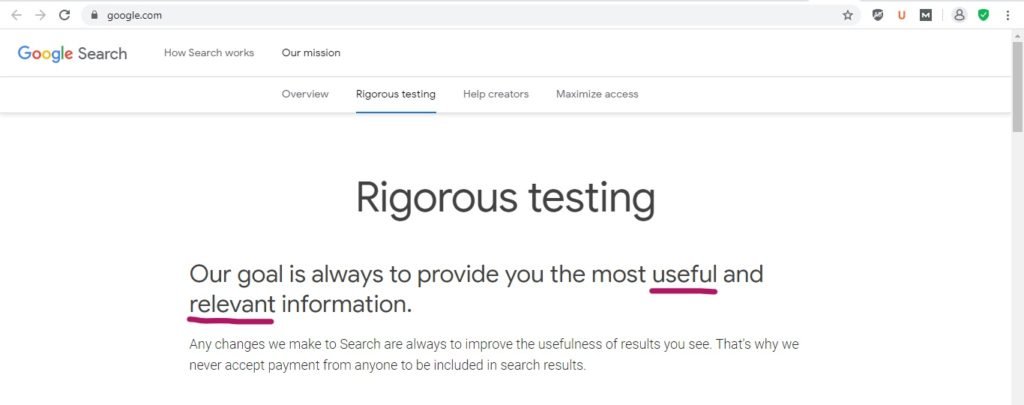
Google wants USEFUL and Relevant Content for the searchers.
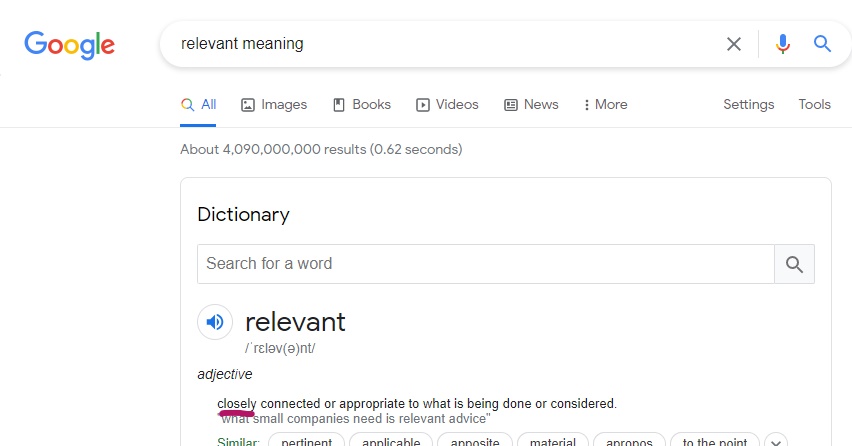
By relevant Google wants you to include not only the information for a specific search query but also content that is closely connected to the search query. This is very important and should be at the back of our minds throughout the content creation process.
If people type their words into the search box and they see those exact same words in the title tags, that going to increase your click-through rate.
Make a List of Questions to Answer
Choose your topic based on questions that resonate with your audience. Who? Problem? Want? Which content is useful to them?
What do your prospects ask? Become the answers to these questions.
Brainstorming on possible questions that your prospects ask can help you come up with the right answers, but yes, it is hard to know what questions are in their mind.
To make your life easier, you can utilize the following platforms to get an idea of what your audience is looking for (pain points).
Forums
Forums are loaded with more content ideas than you could ever possibly use. This is because forum posts can give you clues to where your readers’ pain points are and what you can write about to address them.
Another bonus to utilizing forums for blog post ideas is that the blog post ideas you get are more timely and relevant. Often, a niche will have specific terms that apply to it that may not be used in general conversation.
Check out forums dedicated to your niche by typing your niche in the Google Search box and you will get the top forums in your niche.

Quora
The second platform that you can use for blog post inspiration is a question-based website called Quora. The great thing about Quora is that real people use it to post real questions and has become the best place to explore long-tail keywords and blog topic ideas. This helps you come up with interesting topics for your blog and understand what types of questions people have in your niche.
Head on over to the homepage and log in. If you don’t have an account you won’t be able to see anything more than a login page and so won’t be able to search for ideas. If you have an account this won’t be a problem since you’ll just be able to log in!

Answer the Public
Answer the Public is a fast way to read the minds of millions of people and find those topics worth writing about. You can easily collect and categorize phrases people use when asking questions.
To develop your article, choose a popular search phrase from your niche e.g Affiliate Marketing.

Answer The Public sorts them by usage – and take that phrase as your key topic.
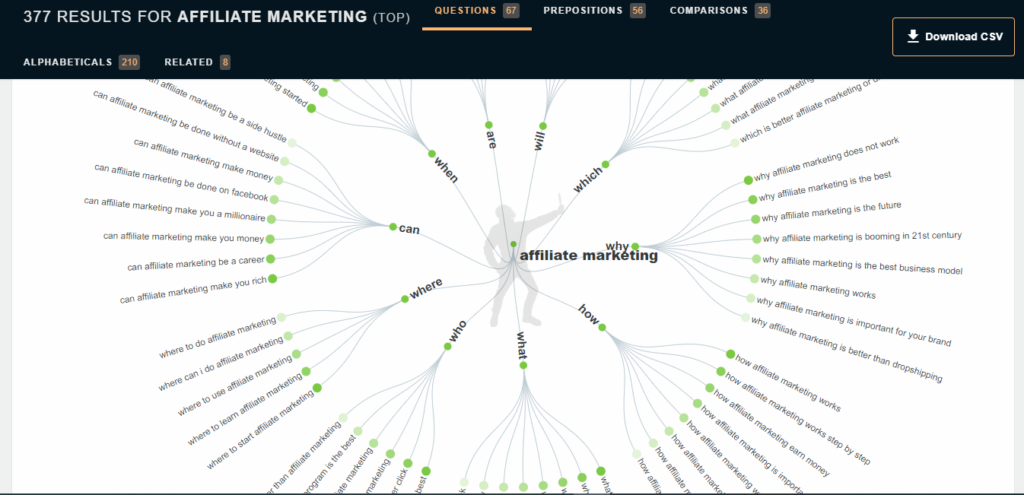
The above results pop up under questions. Use it as the pillar for your content. Then, create subheadings using other related phrases (last tab).
Google AutoFill, Related Searches and People Also Ask
Google AutoFill and Google Suggestions are free tools to help you find related keywords that offer inspiration for content ideas and post topics.
Google Autocomplete
Google Autocomplete is a Google Search feature that provides search term predictions. For example, I typed in the incomplete question is Affiliate…then Google completes it by giving suggestions of what people search. So, as you continue typing, predictions will change.

The suggestions that Google offers all come from how people actually search.
Google Related Searches
Google-related search is a feature on Google that is included in more than 90% of all queries. These eight search results appear at the bottom of the result page and are automatically generated based on Google’s algorithm to determine terms related to your search.
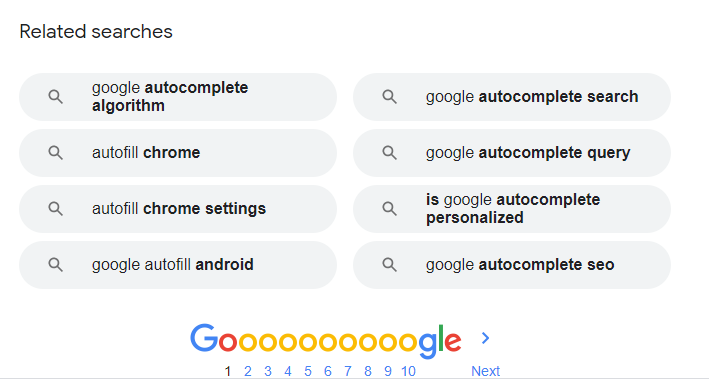
If you add the ubersuggest chrome extension to your browser, (Chrome), you will be able to see more details about the related searches.
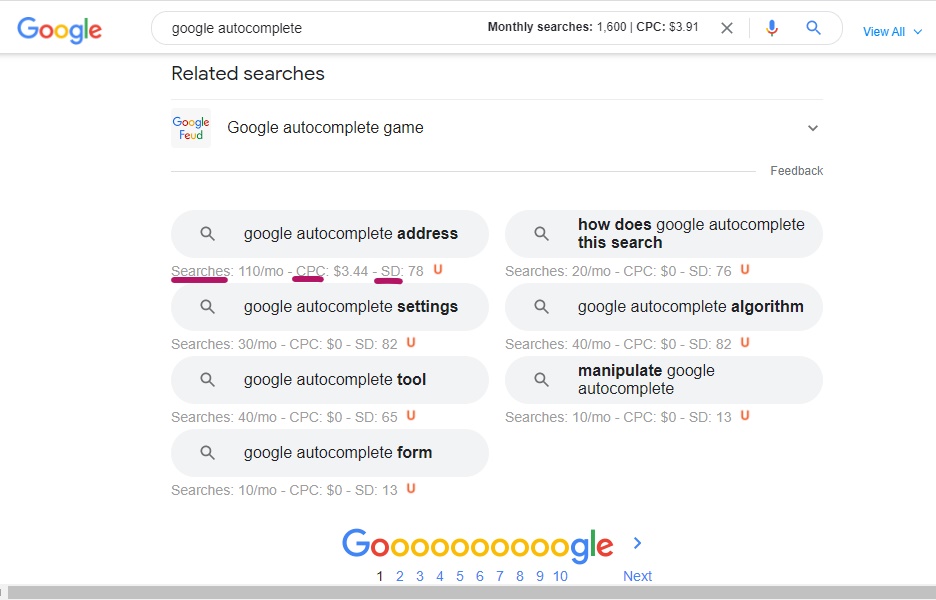
The information displayed using the ubersuggest chrome extension such as search volume, Cost Per Click (CPC) and SEO Difficulty/SD ( competition data) can help help you decide whether the search query is worth going after.
People Also Ask
People Also Ask (PAA) boxes are a dynamic SERP feature, containing sets of questions related to the user’s search query or questions that other searchers have.
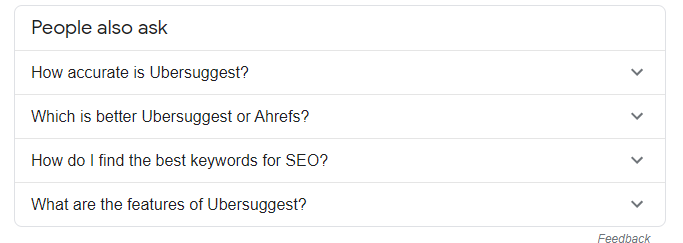
The best way to use these suggestions is to incorporate them in your H2 or H3 subheadings.
Keyword Verification Using a Free Tool
Now that you are clear about your blog idea and know exactly what keyword to target, it is time to get more insights into these keywords using the Ubersuggest chrome extension.
Before the Ubersuggest Chrome extension came along, you needed to use a few different extensions to get the same amount of data. From search seasonality to spikes in clicks, this tool embodies many extensions all in one.
You can easily add it to your chrome browser. Just type Ubersuggest Chrome extension in your browser and you will be prompted to log into the Chrome web store using a Gmail account.
Click the “Add to Chrome” tab and you will be able to use the extension in no time.
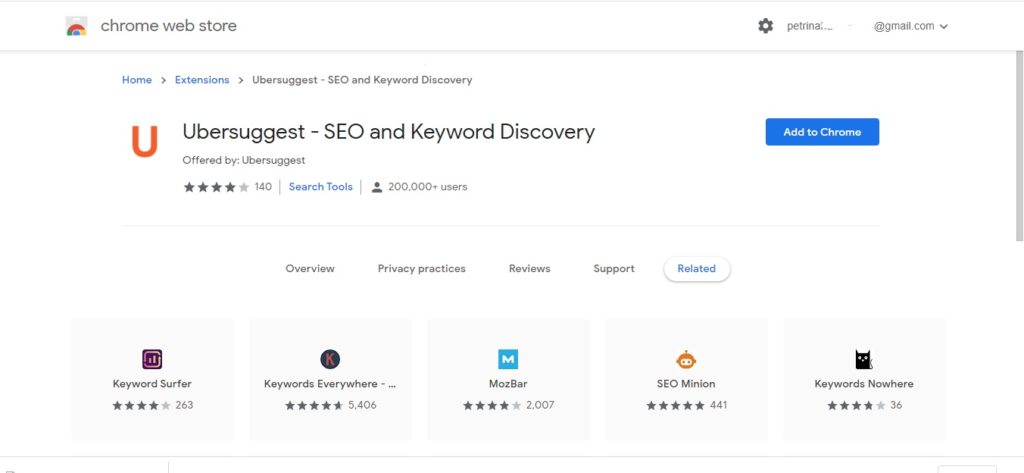
This FREE powerful SEO tool shows you keywords monthly search volume, CPC & competition data.
Once you paste the keyword into the Google search box, you will see the monthly searches and CPC but not the competition data (SEO data). To see the SEO Data (SD), click on view all.

You will see a graph like the one below. Ubersuggest Chrome extension breaks down search volume over the last 12 months as well as shows you mobile and desktop searches.
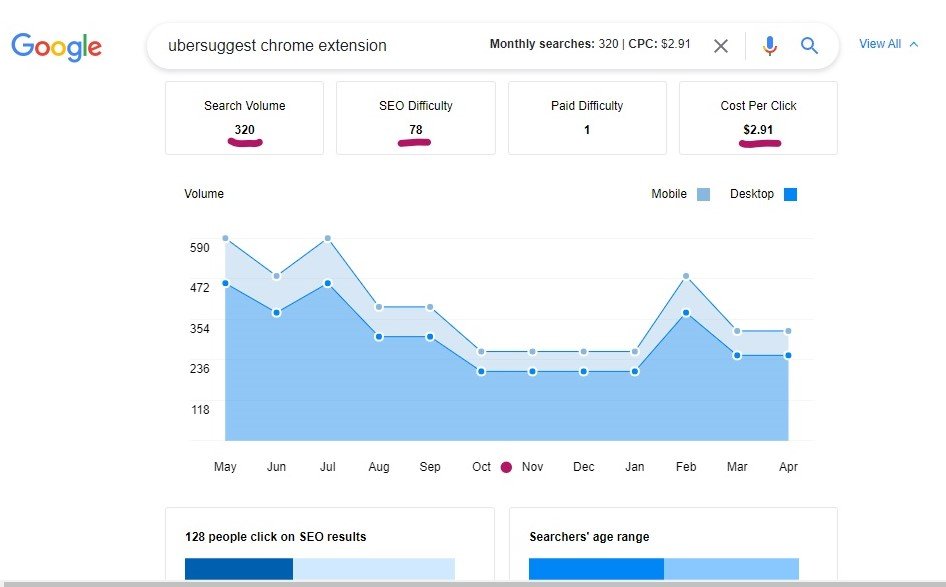
As in the graph above, you can also now see how competitive a keyword is based on the SEO Difficulty.
If your website is new, stick to anything below 40 SD. The difficulty scores are from 1 to 100. The higher the number the harder it will be to compete for that keyword. And the lower the number the easier it is to compete.
Take note though that although the “SEO Difficulty” score that Ubersuggest gives you is helpful, it’s really just a rough estimate that’s based 100% on backlinks. It doesn’t take into account content quality, on-page SEO, PageSpeed, or any other important search engine ranking factors that the main SEO competitors such as Semrush can give you. This is a paid tool but you are given 7 days trial to test it out.
Competitor Analysis of Top 5 Pages
Competitor analysis is a way to identify authors in your niche that have written similar blog posts. By doing research, you will be able to know what other authors think about your chosen topic.
Head on to Google and check the top 10 ranking articles. Why? Because they are following a standard parameter and it is the reason why they made it to the top ten. Follow the best and learn from the best.
Once you have found the top ten articles, read and analyze them without writing anything down. Just scrutinize them in order to draw inspiration from their writing.
Pay special attention to elements that have a big influence on ranking such as:
- Look at their subheadings especially H1 and H2.
- See if they used real-life examples, case studies, statistics.
- Do a content gap analysis: Note down at least 7 things that these ten pages are lacking so that you can improvise upon them in your blog post.
This does not only helps you to clear your idea but also helps you to see what is missing in those articles and includes them in yours to create a better piece.
Go on and create a 10x better article and rank quickly.
Stage 2: Creating a Blog Outline
An outline is an ordered list of the main points of your blog post. It is you knowing ahead of time the general idea of what you’re going to write. An outline, therefore, acts as a road map, the skeleton, the structure, the foundation – you take your pick.
It is important to create an outline before you start writing your blog post. It will act as your guide to effectively sequence your information and organize ideas in thoughtful flow.
Here are steps you must follow to come up with your blog post outline
Pick a Type of Post
Now that you know what content is going to be about, the next step is to choose how you are going to present it. For beginners, I recommend sticking to two types of posts. The “How-To” Post or the Listicle.
What is the difference?
The ” How To ” Post
The How-to-post describes how to execute a process. It goes into detail on every step and makes the process you’re explaining is super clear to the reader. You can use images, video, or audio to enrich the post.
Reading large blocks of text is also taxing on the brain, requiring more energy and focus. It is therefore very important to put a call to action at the end of your blog post. This makes it as easy for your visitors to take action.
The Listicle
Listicles are a great way to organize and present actionable information, statistics, and hard facts while staying focused on one topic. You can create a list of books, tools, resources, or literally anything else your audience will find useful.
These types of blog posts are a good option when you want to recommend different resources to your audience.
Now, let’s get started with our outline
How to Title Blog Posts for SEO
Don’t overlook page titles. A better title means your article has a chance of being read, even ahead of pages that are ranked above you. Create titles that blow your potential readers away.
Headline Writing Tips for More Clickable, Shareable Blog Posts
- Write interesting titles to grab readers’ attention.
- Integrate SEO keywords, but only if they fit in.
- Make a promise and fulfill it.
- Include a number (If it fit in).
- Grab attention with impressive and descriptive language.
- Ask a question to spark curiosity.
- Headlines should also be compelling, which means they ought to inspire user interest.
- Do not write too long titles. Google starts cutting off title tags in the SERPs after around 50–60 characters by adding an ellipsis (“…”) and could end up omitting important words.
- Use eye rest such as : or – for lenghty headlines.
- Use title case
- Do not put full stop. It acts as a mental stopping points readers.
If you are stuck, SEOPressor is a free tool that can help you with blog titles.
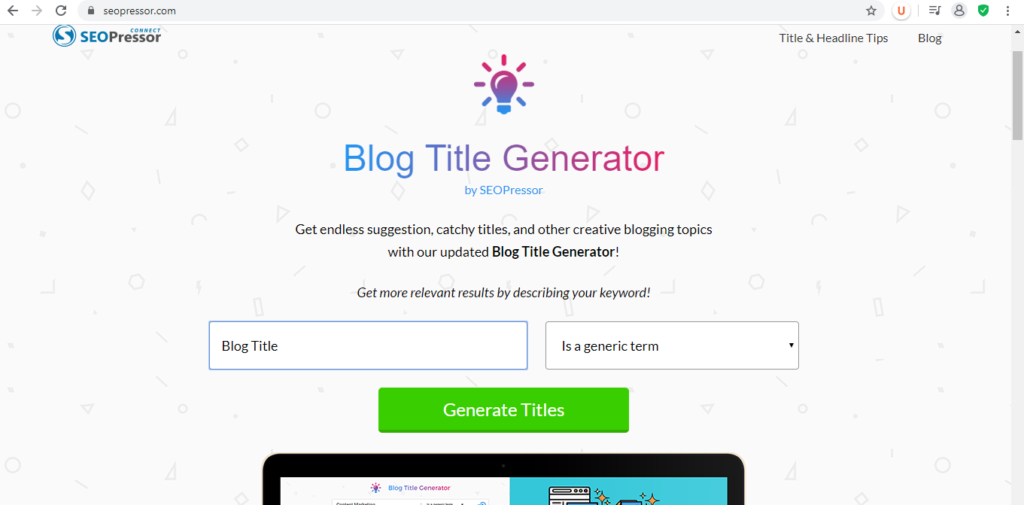
Write Irresistible Subheadings
The subheads are the related topics that expand on the idea presented in the main heading. Generally, there should be at least three subheadings within a 500-word blog article.
Importance of Subheadings
Subheadings play an important role in every blog post:
- Subheaders help search engine bots decipher your content and figure out what it is all about.
- Attract attention: They stand out because of their size.
- The scanner will stop to read them and continue scanning until the next subhead which they’ll then read.
- Scanning from subhead to subhead, they serve to guide the reader down the page.
Tips to Help You Prepare Great Subheadings (h2, h3, h4)
Keep the length similar: To write a powerful heading, keep it at 70 characters or less. This will help you keep readers at your content, and make your point brief yet powerful.
Connect to the headline: Link each sub heading back to the content’s main heading.
Continue moving forward: Every subheading must have a text that goes deeper into the blog post and moves the reader farther along on the path to understanding the topic.
Write a Sentence Outline for each subheading
Now that you have come up with subheadings, it is time to write the main points under every subheading.
How many points do you need to include under every subheading? It depends on your blog post type and length.
Outline the Introduction
A good intro outline will help you write a good introduction. Your outline for the introduction should state the blog post’s hook, transition, and thesis.
The hook: It is a description, illustration, narration, or dialogue that pulls the reader into your blog post topic. Make it specific, brief, and interesting.
The Transition: It is a Sentence(or two) that connects the hook with the thesis.
The Thesis: The last element of an introduction is the thesis. It is a sentence (or two) that summarizes the overall main point of the blog post. It serves as the foundation and frame for whatever argument you want to make or point of view you want to advocate.
I usually wait until I’ve worked out the blog post details post before I start writing the blog intro. This is mostly because will use my intro to tease the content below it, and I may not know what that content is until I have come up with the main points.
Why would I go ahead and write most of the intro in an outline?
Intros are the most important part of your post. It is the second most critical part of your blog post after the post title. It provides context to your readers to prepare them for your blog post.
Outline Conclusion
Your conclusion will depend on your message, the format of your blog, and your audience. Just keep it short and sweet. Here are tips to help you come up with a powerful conclusion that can be beneficial to you and your audience:
- It should be a summary.
- Ask a question.
- Direct your readers to do something.
- Inspire your audience.
- Provide links to another blog post.
By writing a powerful conclusion, you will leave your readers energized and leaping out of their chairs, ready to move mountains, make big decisions, or at least try something new. You’ll inspire your readers to take action.
Revise the Entire Outline
It is very crucial to do several review passes. You may be surprised at what opportunities you miss the first and even the second time around. So, revise, trim and clean up your blog post outline. This is the most important step of this entire process.
Here are my suggestions on how to revise your outline:
- Read the outline from beginning to end. Check if you have missed out on something.
- Go back to the 5 top-ranking articles. Make a comparison between your outline and theirs. Is there anything else you can do to make yours better than theirs?
- Trim: Remove anything repetitive, or change the order of your headings if necessary.
Stage 3: Create (Expand Your Outline)
Now once your blog outline is ready, you need to head over to the content editor of your choice and start filling in the outline. Don’t use WordPress editors while writing, google docs has an autosave feature.
With the detailed outline in place, you’ll truly be astonished by seeing the speed at which you will be able to write the blog post. Just Make sure you are through with the topic before writing.
While Writing the Blog Post, Do This:
- Write without any distractions. Find a quiet place (when there is an opportunity).
- Write the article in free flow. Do not try not to read the article while writing, it will reduce your productivity.
- Keep it as real as possible. write like you are talking to a friend and try to explain your thoughts on the topic.
- Don’t include the images when you are writing. Instead, you can add the name of the image, and after you are done upload the file.
Write for Readers Who Scan
In the visual presentation of your blog, formatting can make or break whether or not someone wants to continue reading your blog post. A key point to structuring and formatting your blog is to make it reader-friendly by using paragraphs, bullet points, or numbers. Here’s my best advice:
- Keep each paragraph focused on a single idea.
- Make important concepts stand out with bullets and Lists.
- Keep your paragraphs and sentences short.
This is crucial because most people only read 20%. Scannable content kills two birds with one stone. It improves the user experience because readers can quickly move through a large volume of content and find little nuggets of information they are looking for.
Check Spelling and Grammar
Once you are done with writing, check grammar and spelling.
I use a free tool called Grammarly.

You can even get a free chrome extension and check your spelling and grammar without leaving your editor, as long as you log in to get more features.
Step 4: Optimize Your Blog Post (On-page SEO)
On-page SEO (also called on-site SEO) refers to all measures that can be taken in order to optimize web pages to rank higher in search engines. Below are the 4 most important on-page SEO considerations you need to focus on to succeed.
Title Tag
A <title> tag is an HTML element that specifies the title of a web page. In simple language, the title tag names your website and tells search engines what it is. So, they are the second element of SEO that you need to take into consideration because search engines analyze them when determining how to rank your page. Keywords play a major role in that respect.
While you can technically use more than one keyword in your title tag, I recommend that you use only one, or two if they are closely related, or else it will look spammy.
Each title should contain a keyword near the beginning. This will help Google to recognize the relevance of your content to the query.
Post Meta Description
An average internet user looks at two things prior to opening a webpage. They look at the headline and meta description.
The meta description is always displayed below the webpage title in Google search results.
A good meta description should be:
- 135 to 165 characters
- Include the main keyword
- Relevant to the page content
- Actionable: State exactly what action that you want people to take, for instance, “click here”, “buy now”, or “learn more”.
The fact that search engines highlight keywords in the meta description. This encourages people to click the link and check out your content.
H2 and H3 Sub-headers
Your target Keyword should appear in subheaders (H2 and/ or H3) in form of synonyms if possible
You can find these synonyms by using Thesaurus or Google Related Searches.
Keyword phrases sprinkled in subheaders and bold text on the page, you have got a very good opportunity to rank for half a dozen phrases on a single page.
You may take these keywords (synonyms) and integrate them within your copy, wherever it flows smoothly and organically.
Use Image Alt Attribute and Compress them for Fast Page Load Speed
Done with your writing? It is time to, add images. To optimize your image for search engines:
- Giving your a proper name. It will help search engines to understand your image in a better way.
- Don’t use filenames like untitled .jpg. These kinds of files hurt your image SEO. Your image file name plays an important role in its ranking on search engines, so take time to name it properly.
- Compress your images with a free WordPress plugin called Smush.

Internally and Externally Link to Other Valuable Content
External links ( a.k.a backlinks or inbound links) on the other hand refer to hyperlinks that direct the reader to a reputable page on a different website.
Internal links are hyperlinks that direct the reader to a target page on your website. It is a strategic way to connect your content, as long as it’s something that the reader will be interested in.
You can use both internal and external links to foster good SEO and content ranking.
Benefits of External Links to Your Content Marketing Strategy:
- Build trust in your content. The more people trust your content, the more likely you are to rank well. Search engines view them as third-party votes for your website.
- Help you establish yourself in your industry’s community and grow your brand.
- Increases loyal readers and customers.
Benefits of Internal links to your content marketing strategy:
- Internal linking makes your site SEO-friendly.
- Help users use links to navigate through your site and to find the content they need.
Recap on Blog SEO
- Use the targeted keyword in the title (H1 tag in Worpress).
- Analyze the URL structure of your articles.
- Check each page for meta titles and descriptions.
- Most articles should have at least 2 or 3 subheadings (though depends on length).
- Use related keywords (synonyms) in H2 or H3 tags (subheadings).
- Find related keywords with Thesaurus or Google Related Searches.
- Use keyword 2 to 4 times in the article.
- At least at the beginning and end of the article preferred.
- Link liberally to articles in the same categories (linking to other categories is ok too). Start with 5-7 categories on your site.
- Check ALT tags on images.
- Conduct a Mobile website test to see if your website is properly optimized for smartphone usage.
Final Thoughts on How to Write SEO Friendly Blog Posts
I know… there’s a lot to it!
I’ve tried to cover everything, from Keyword Research and writing tips, to blog outlining and OnPage SEO. Writing an SEO-friendly blog post usually results in giving useful information.
The aim is not to write more blog posts, your article should be valuable to your audience. Write to cover a topic very well. Just give it your best.
Keep using my step-by-step guide until it becomes natural to write an SEO Friendly Blog post. My ultimate goal is to help you in answering the queries of your reader and build a community.
By following this strategy for all the terms you want to rank for, you will naturally boost your organic traffic over time.



![How to Increase Brand Awareness Successfully [Strategy] Innovative-Ways-to-Increase-Brand-Awareness](https://createandleave.com/wp-content/uploads/2020/08/brand-awareness.png)






